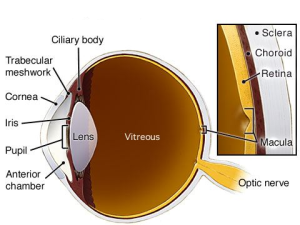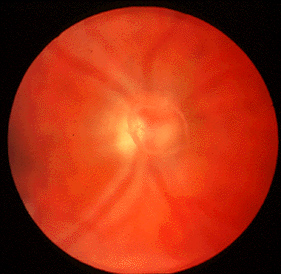What are Floaters?

The technical term for these visual phenomena are called Muscae Volitantes which is Latin for “Flying Flies.” No one refers to them that way though, they are simply called floaters. Commonly floaters are noticed as specks, strands, or ‘ameba-like’ see through forms that drift through the vision from time to time. They will often move as the eye moves and appear to change shape as they float about.
 The first important thing to know is that floaters come from, and form in, the jelly of the eye called the Vitreous (right). Floaters can form at any age and can range from mild to severe.
The first important thing to know is that floaters come from, and form in, the jelly of the eye called the Vitreous (right). Floaters can form at any age and can range from mild to severe.
The jelly inside the eye is quite thick and gel-like as a child but over our lifetime it breaks down and liquefies. As the jelly liquefies, it gets sticky and clumps begin forming.
These floaters are suspended within the jelly of the eye and with eye movement they become “shook up” and drift about similar to snow floating inside a snow globe. As these clumps pass through the center part of vision you will see the shadows of them.
Floaters tend to more visible against a flat background, like a bright blue sky or a freshly painted wall. Additionally, floaters are more pronounced in bright environments because bright lights make the pupil smaller which casts a more visible shadow from the floater onto the retina.
Below is a fun and quite educational video explaining floaters (as well as another commonly described and really cool “eye quirk” called the Blue Field Entoptic Phenomenon… that’s so cool it deserves a blog post of it’s own).
Should I get checked if I see Floaters?
While hugely annoying, floaters in general are a normal and mostly benign condition. It is important to note however, that any new or changing presentation of floaters should be examined for a potential eye problem.
As anyone who’s gotten a corneal abrasion can attest to, the surface of the eye is highly enervated and sensitive. By contrast, there are no nociceptors (or cells that sense pain) inside your eye. Therefore, if you develop a problem on the inside of your eye like a tear in the retina, a bleed, or an infection, you will feel no pain; your only symptoms will be an increase in the floaters you see.
Additionally, floaters in conjunction with bright flashes or arcs of light in the side vision, is cause for concern and should be checked. Flashes of light come from traction of the jelly on the retina and could lead to a problem.
One Floater to ALWAYS get checked
 One specific type of floater that should always be investigated is something called a Posterior Vitreous Detachment (or PVD for short). PVDs occur as the liquefying jelly in our eye begins to collapse in on itself and peels away from the lining inside the eye, called the retina.
One specific type of floater that should always be investigated is something called a Posterior Vitreous Detachment (or PVD for short). PVDs occur as the liquefying jelly in our eye begins to collapse in on itself and peels away from the lining inside the eye, called the retina.
This process is a near guarantee with age, occurring in about 50% of humans at age 55, up to 86% by 90. When the vitreous, or eye jelly, pops off its attachment to nerve in the back of the eye, it leaves a very large, very annoying circular floater right in the center of vision. This floater is referred to as a Weiss Ring (pictured left).
The problem here is not the floater itself. Instead, as jelly peels away from the retina, it will often tug on the retina and has to potential to cause retinal tears in up to 10% of patients with an acute PVD.
Is there a treatment for Floaters?
The vast majority of the time floaters are a normal, albeit irritating, condition. Since these little buggers are actual inhabitants inside the eye, there is no simple treatment to remove them.
One option is something called a vitrectomy, where a retinal surgeon removes the jelly of the eye and replaces that jelly with saline. This is a significant operating room type surgery with lots of potential complications and therefore is rarely performed for floaters alone.
A newer treatment option that has surfaced in the last decade is to use a high powered laser to essentially “blow up” the floaters. While a novel approach, putting this much laser energy into an eye has the potential for very serious complications making this a very questionable approach.
What we do have going for us is that over time the brain will learn to “see” floaters less and less and gravity will also take it’s toll and floaters will sink out of vision.
Bottom line, the best treatment for floaters: try to ignore them.
We hope this discussion has answered some of the questions you had about Floaters. If you think of any other questions, feel free to let me know!
Take care of those eyeballs!
– Nick Wolf, OD
For additional reading material on Floaters, please visit the Mayo Clinic’s excellent page.


